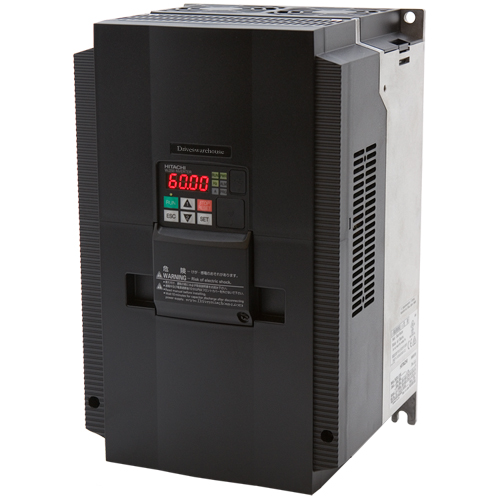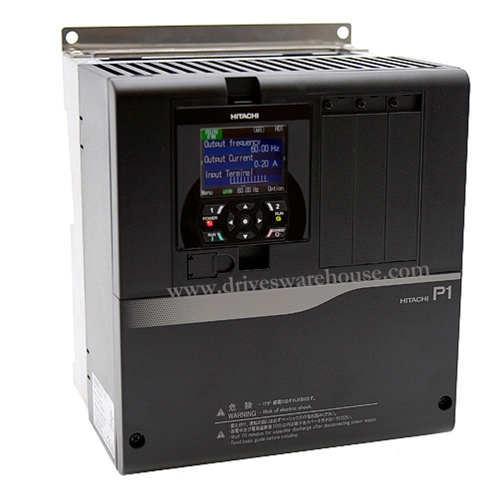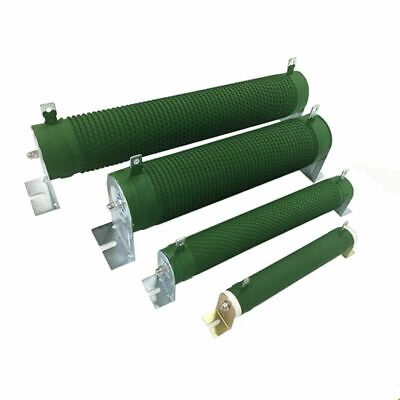-
Welcome back Guest! Did you know you can mentor other members here at H-M? If not, please check out our Relaunch of Hobby Machinist Mentoring Program!
You are using an out of date browser. It may not display this or other websites correctly.
You should upgrade or use an alternative browser.
You should upgrade or use an alternative browser.
Which VFD for 10 hp spindle
- Thread starter Karl_T
- Start date
- Joined
- Feb 25, 2021
- Messages
- 3,129
Sorry, repost was a cell phone mistakeYou don’t need the encoder. It is helpful for maintaining extremely low rpm or very precise rpm regardless of slip.
You can always play with pulley size on the motor to get your ideal performance.
Last edited:
- Joined
- May 23, 2017
- Messages
- 109
I'll throw my recommendation of a Teco 20HP for $1000
 dealerselectric.com
I have 4 Teco VFDs in my shop, Also Hitachi and Mitsubishi. My big lathe has a 7.5HP motor, and is powered with a 7.5HP Mitsubishi. For the first time a month ago I tripped the breakers, as I set the acceleration to .5seconds, and had the spindle gears set for 1150RPM. I was installing braking resistors for the first time.
dealerselectric.com
I have 4 Teco VFDs in my shop, Also Hitachi and Mitsubishi. My big lathe has a 7.5HP motor, and is powered with a 7.5HP Mitsubishi. For the first time a month ago I tripped the breakers, as I set the acceleration to .5seconds, and had the spindle gears set for 1150RPM. I was installing braking resistors for the first time.
The one design error I see in all VFDs, you can only set one deceleration time. This needs to be a function of the max Hz being decelerated from. So low RPM can have a fast stop, vs the time it takes from 800RPM with a 12 inch chuck, that needs a longer time.
Teco-Westinghouse, MA7200-2020-N1, 20 HP, Variable Frequency Drive 230 Volt, 1 or 3 Phase Input, NEMA 1, at Dealers Industrial
Purchase Teco-Westinghouse, MA7200-2020-N1, 20 HP, Variable Frequency Drive 230 Volt, 1 or 3 Phase Input, NEMA 1, from Dealers Industrial
The one design error I see in all VFDs, you can only set one deceleration time. This needs to be a function of the max Hz being decelerated from. So low RPM can have a fast stop, vs the time it takes from 800RPM with a 12 inch chuck, that needs a longer time.
- Joined
- Jun 12, 2014
- Messages
- 4,811
As mentioned and encoder is not useful unless you need positional control for CNC, with sensorless vector mode you have very tight speed regulation. If you have the space you can just leave it or remove it. On tight fits I cutoff the rear jack shaft. I have seen quite a few people use the Marathon vector motors on their 10EE. The Hp used is really dependent on if you are going to retain the back gear or just use a direct drive. A 5 Hp vector motor is a good fit when using the back gear, but if direct I typically see people use the 7.5 or 10 Hp. I think the ideal design and what is used on current factory 10EE is 2 speeds with a 5 Hp motor and a VFD. Something to be said for the older DC motors designs, but a real challenge to get them in working order. I worked on a recent build with a S&B 1024 which was very similar to the 10EE, it had a back gear so we put in an ABB 5HP Vector motor and used the WJ200-075LF. On a few other Sunmaster 5Hp lathes I used the Yaskawa CIMR-VU2A0040FAA.
Many VFD's allow you to set from 2-4 acceleration and deceleration rates, usually stage 1 or stage 2, some have a binary of two inputs for 4. One can quickly run out of VFD inputs for various functions, most that I use have 7, some more. Acceleration/deceleration time is based on the maximum speed attainable so if you are running a motor to 180 Hz with it set to 3 seconds then it will be 1 second at 60 Hz. So you need a switch for setting the rates. You must use an external braking resistor to get effective braking with any high momentum system (and also with wide speed ranges). They are not expensive, I typically buy them through Mouser Electronics or Digikey under power resistors. The better VFD's have settings to modulate the braking time if the buss voltage is getting too high, rather than go into an over voltage or current fault mode and free run to a stop. There may also be some factor as to VFD design and if it is operating close to its maximum ratings. I have had no issues with the Yaskawa drives, but there are a ton of people that have also used the Hitachi WJ200 which might be the most cost effective. I have worked with a few people that installed the Mitsubishi VFD's, found their manuals to be a bit more difficult, but have limited experience with them. Different vendors push different models.
FYI, the maximum speed on the Balor vector motor is shown a maximum safe speed of 6,000 RPM per the motor spec sheet on P7, although that is the ABB version in the packet. Haven't seen that in this size motor. A reasonable speed range for this motor would be 15-180 Hz, the Marathon BlackMax would be probably be in the 15-150 Hz range, although in another form they mentioned pushing these higher w/o issues. All vector rated motors I have seen have a CT of 1000 or 2000:1.
Many VFD's allow you to set from 2-4 acceleration and deceleration rates, usually stage 1 or stage 2, some have a binary of two inputs for 4. One can quickly run out of VFD inputs for various functions, most that I use have 7, some more. Acceleration/deceleration time is based on the maximum speed attainable so if you are running a motor to 180 Hz with it set to 3 seconds then it will be 1 second at 60 Hz. So you need a switch for setting the rates. You must use an external braking resistor to get effective braking with any high momentum system (and also with wide speed ranges). They are not expensive, I typically buy them through Mouser Electronics or Digikey under power resistors. The better VFD's have settings to modulate the braking time if the buss voltage is getting too high, rather than go into an over voltage or current fault mode and free run to a stop. There may also be some factor as to VFD design and if it is operating close to its maximum ratings. I have had no issues with the Yaskawa drives, but there are a ton of people that have also used the Hitachi WJ200 which might be the most cost effective. I have worked with a few people that installed the Mitsubishi VFD's, found their manuals to be a bit more difficult, but have limited experience with them. Different vendors push different models.
FYI, the maximum speed on the Balor vector motor is shown a maximum safe speed of 6,000 RPM per the motor spec sheet on P7, although that is the ABB version in the packet. Haven't seen that in this size motor. A reasonable speed range for this motor would be 15-180 Hz, the Marathon BlackMax would be probably be in the 15-150 Hz range, although in another form they mentioned pushing these higher w/o issues. All vector rated motors I have seen have a CT of 1000 or 2000:1.
Attachments
- Joined
- Oct 14, 2014
- Messages
- 1,970
Ok, if five Bens bring home the black max; i will go that way. If not its the Baldor.
Then this VFD: Hitachi Wj200-110lf

The discussion on inputs to change decel times based on speeds is something I need. Not totally clear on this. At this time, just tell me what all additional parts to order - two inputs for four speed ranges??? I assume the above VFD can handle this.
I will read up on which brake resistor and which speed pot to get these on the way.
Then this VFD: Hitachi Wj200-110lf

WJ200-110LF
The discussion on inputs to change decel times based on speeds is something I need. Not totally clear on this. At this time, just tell me what all additional parts to order - two inputs for four speed ranges??? I assume the above VFD can handle this.
I will read up on which brake resistor and which speed pot to get these on the way.
- Joined
- May 23, 2017
- Messages
- 109
The Mitsubishi (E520-5.5K) is a 2004 era design. I put the brake resistor on it, as when I did move the carriage FWD/REV lever to off, then back on, if it had not finished coasting to stop, it would force decelerate to zero, then accelerate back up. It has no ability to recapture the current motor speed, and say's so in the manual. So the main reason for the brake resistor is to hasten the deceleration to stop to limit this design feature.<snip>
Many VFD's allow you to set from 2-4 acceleration and deceleration rates, usually stage 1 or stage 2, some have a binary of two inputs for 4. One can quickly run out of VFD inputs for various functions, most that I use have 7, some more. Acceleration/deceleration time is based on the maximum speed attainable so if you are running a motor to 180 Hz with it set to 3 seconds then it will be 1 second at 60 Hz. So you need a switch for setting the rates. You must use an external braking resistor to get effective braking with any high momentum system (and also with wide speed ranges). They are not expensive, I typically buy them through Mouser Electronics or Digikey under power resistors. The better VFD's have settings to modulate the braking time if the buss voltage is getting too high, rather than go into an over voltage or current fault mode and free run to a stop. There may also be some factor as to VFD design and if it is operating close to its maximum ratings. I have had no issues with the Yaskawa drives, but there are a ton of people that have also used the Hitachi WJ200 which might be the most cost effective. I have worked with a few people that installed the Mitsubishi VFD's, found their manuals to be a bit more difficult, but have limited experience with them. Different vendors push different models.
<snip>
I've not seen in the manual that ability to have a binary selector for different decelerations.
- Joined
- Jun 12, 2014
- Messages
- 4,811
I think you made the best decision with that motor, I have done a few VFD builds with them and they are killer and pretty much unstoppable.
Given the high efficiency/lower current draw of that motor (25A), on the VFD it may open a few other options. With this motor I would look at the Hitachi P1-00600-LFUF used with a 40A DC choke which should give you a bit more headroom on the derating.
Doesn't get much better than this for pricing: https://www.ebay.com/itm/MTE-DC-LINK-CHOKE-DCA004004-40-AMPS-40A-2MH/114452029021
I would call either Drives Warehouse or Wolf to verify this is a suitable VFD for the motor and also that it can be used for single phase. They indicate it can be used for single phase use, but the manual has some warnings on the subject.

 www.driveswarehouse.com
www.driveswarehouse.com
I haven't worked with the newer Hitachi P1 line, but it does often a lot more features and the price difference between it and the WJ200-110LF is about $100. I can workout the parameters and programming suggestions.
Most of the newer VFD's have both 1 and 2 stage braking ability, and also controlled acceleration deceleration to prevent buss tripping, the older Mits. does not have this feature. The Yaskawa V1000 has 4 settings, but I only use 2. The Hitachi P1 also has a multitude of setting for this, do not have time to go into into detail. I would need to spend some time going through the manual.
Mark
Given the high efficiency/lower current draw of that motor (25A), on the VFD it may open a few other options. With this motor I would look at the Hitachi P1-00600-LFUF used with a 40A DC choke which should give you a bit more headroom on the derating.
Doesn't get much better than this for pricing: https://www.ebay.com/itm/MTE-DC-LINK-CHOKE-DCA004004-40-AMPS-40A-2MH/114452029021
I would call either Drives Warehouse or Wolf to verify this is a suitable VFD for the motor and also that it can be used for single phase. They indicate it can be used for single phase use, but the manual has some warnings on the subject.

P1-00600-LFUF
I haven't worked with the newer Hitachi P1 line, but it does often a lot more features and the price difference between it and the WJ200-110LF is about $100. I can workout the parameters and programming suggestions.
Most of the newer VFD's have both 1 and 2 stage braking ability, and also controlled acceleration deceleration to prevent buss tripping, the older Mits. does not have this feature. The Yaskawa V1000 has 4 settings, but I only use 2. The Hitachi P1 also has a multitude of setting for this, do not have time to go into into detail. I would need to spend some time going through the manual.
Mark
- Joined
- Feb 25, 2021
- Messages
- 3,129
I think you'll be more than happy. I do suggest spending some time with the VFD instructions. Get it working to basic settings, than go back in and start tweaking rpm limits, acceleration/decerleration, trip parameters, etc. Keep in mind that your lathe won't approach the full capability of the motor except very briefly in an deep cut at low RPM, so you are *very* unlikely to hurt the motor as long as you get the FLA correct. Nor are you likely to hurt the VFD. Just don't put a switch or anything not called for in the VFD manual between the VFD and motor.The baldor is mine. i offered $500 and he took it. $200 to ship.
Thanks everybody for all the GREAT HELP.
Karl
For example, I have a Teco L510 on my Monarch CK with a Baldor 3HP motor (not as wide of a torque range as the motor you got). I set the acceleration as something conservative, like 10 seconds. After coming up to speed, occasionally the VFD would trip out when engaging the clutch too fast in higher gears with a heavy chuck. I found there was a parameter that was disabled by default, that allowed the VFD and motor to slow down a bit and then speed back up on hitting full load (FLA) rather than tripping out, which I enabled. Now I can set the acceleration to a few seconds (maybe 3) and if I close the clutch quickly the motor just slows down for a second rather than the VFD tripping out. Note this is actually a combination of several parameters, as tripping out during acceleration, vs tripping out during constant RPM, are different parameters.
After getting it running and using it a while, I actually programmed the VFD to output total % FLA on the analog output, and ran that to a meter. Now if I'm taking a deep cut I can look at the meter and see how much I'm actually loading the motor. Just little things that are possible by digging through the VFD details. Been running that lathe now for about a year with that setup.
Last edited:
- Joined
- Oct 14, 2014
- Messages
- 1,970
OK, been reading the manual. of course its all laid out different than other VFD manuals, takes forever to find stuff.
Its calls for a 2K ohm 1 watt pot for speed control
Not sure on brake resistor. Page 20 - 3 of https://www.driveswarehouse.com/Assets/Document/P1CM.pdf indicates 10 ohm minimum. No call on watts that I see.
Would this offer at 10 ohm 1000 watt be a good choice

Also there is a multi conductor cable to move the readout on the VFD to a remote spot. do not know what to call this or where to order it.
Its calls for a 2K ohm 1 watt pot for speed control
Not sure on brake resistor. Page 20 - 3 of https://www.driveswarehouse.com/Assets/Document/P1CM.pdf indicates 10 ohm minimum. No call on watts that I see.
Would this offer at 10 ohm 1000 watt be a good choice

1Pc Power Coated corrugated Wire-wound Resistor 5% Fixed Type Tubular Shaped | eBay
Price for 1Pc!
www.ebay.com
Also there is a multi conductor cable to move the readout on the VFD to a remote spot. do not know what to call this or where to order it.
Last edited:

